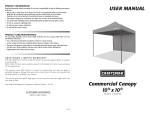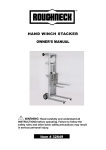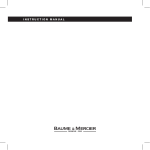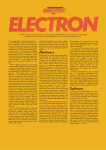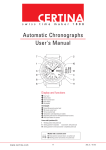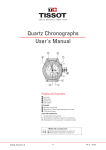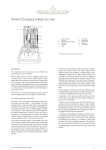Download Instructions for use Mode d`emploi GRANDE COMPLICATION
Transcript
Instructions for use Mode d’emploi G rande C omplication R oyal O ak et J ules A udemars Calibre 2885 Selfwinding < < 2 9 1 9 Royal Oak 3 6 3 2 1 8 6 8 7 Jules Audemars 7 5 5 ; : ; 4 : 4 c c f e f e d d k k g i A j g i A B h h j B English 1 Introduction p 41 The Manufacture Audemars Piguet The Grande Complication Corrections if the watch has stopped for more than 3 days 1. The leap-year 2. The month p 50 4. The day 5. The week Views of the movement Movement technical data Watch indications and functions 6. The moon phase Table of contents 3 Basic functions English 3. The date 2 Watch description 7. Time reset p 55 Setting the time Time-zone adjustments Winding the watch Functions and use of the split-seconds chronograph Functions and use of the minute repeater Adjusting the perpetual calendar indications The moon phase The leap-year cycle Corrections if the watch has stopped for less than 3 days 4 Accessories p 67 Rotating presentation case Sounding board Setting stylus 5 Additional comments p 69 Quick-link contents page. Simply click on the relevant title or subheading to following the link to your chosen section. Click on the white “English” to return to the main contents page. 38 39 English The Manufacture Audemars Piguet 1 Introduction The Vallée de Joux : cradle of the watchmaker’s art I n the heart of the Swiss Jura, around 50 kilometres north of Geneva, nestles a landscape which has retained its natural charm to this day : the Vallée de Joux. Around the mid-18th century, the harsh climate of this mountainous region and soil depletion drove the farming community settled there to seek other sources of income. With their high degree of manual dexterity, inexhaustible creativity and enormous determination, the inhabitants of the valley, known as Combiers, were naturally drawn to watchmaking. Due to their high quality, the movements they produced acquired great popularity with the Geneva firms which used them to create complete watches. From 1740 onwards, watchmaking developed into the principal industry of the Vallée de Joux. This region was thus transformed, as an 1881 chronicle put it, “ into a land of milk and honey, in which poverty has rapidly disappeared ”. 40 41 n 1875, two young men passionate about Haute Horlogerie — Jules-Louis Audemars and Edward‑August Piguet — decided to pool their skills to design and produce watches with complications in the Vallée de Joux, the cradle of Haute Horlogerie. Determination, imagination and discipline led them to instant success. A branch in Geneva was their next move in about 1885 and new commercial links were forged at the 1889 Paris World Exposition, where they exhibited complication pocket watches. The Audemars Piguet factory continued to expand as the years went by. Its creations represented major milestones in the history of Haute Horlogerie, like the first minute repeater wristwatch in 1892 and the smallest five-minute repeater movement ever made in 1915. From 1918 onwards, the founders passed the reins of the business onto their sons, who in turn perfected their expertise in manufacturing men's and ladies' wristwatches as well as designing new sophisticated, ultra-thin movements. Perseverance and initiative were the watchwords : while the Wall Street crash in 1929 was a bitter blow, the company directors were soon designing so-called skeleton watches before embarking on chronograph production. 42 English I But this new momentum was abruptly interrupted by the Second World War. Re-organisation was necessary in the aftermath of the conflict. The factory focused on creating top-of-the-range items in keeping with its tradition of innovation. A strategy that would prove its worth, especially since it was backed by outstanding creative daring. Audemars Piguet continued to build on its now international reputation with creative designs. 1972 saw the launch of the Royal Oak, the first, immediately successful high-quality sports watch in steel, followed in 1986 by the first ultra-thin tourbillon wristwatch with automatic winding. The creative spirit of the Manufacture has not faltered since, offering aesthetically original timekeepers with outstanding movements. Thus it brought watches with complications back into fashion at the end of the 1980s, launching its extraordinary Tradition d’Excellence collection in 1999. All the signs of a bold spirit rooted firmly in tradition and auguring well for the future. 1 Introduction Two names for a great adventure 43 “ Grande Complication ” W 1 Introduction English hat is a “ Grande Complication ”? The layman would compare it to an intr icate maze, whereas a watchmaker would say that a major complication allows a timepiece to reveal more about time. The master watchmaker — a virtuoso of arrangements that might seem improbable to others, enamoured of fine workmanship as well as cutting-edge technology — knows that a Grande Complication takes the finishing process to the limit. Yet again, this proves how the hand of a skilled craftsman makes all the difference. Complications can be classified in three categories. The first consists of watches with one or several additional hands to indicate the time (e.g. the chronograph, split-seconds and jumping seconds chronographs). The second contains all watches featuring striking mechanisms. The third refers to watches with mechanisms that provide astronomical indications (e.g. date, moon phase and equation of time). The prestigious " Grande Complication " designation is bestowed upon a watch that possesses at least four different functions out of these three categories. It takes great mastery to create a timepiece offering excellence in every department : design and reliability, as well as prec ision. The Calibre 2885 by the Manufac ture Audemars P iguet is a case in point. Fourteen lignes in diameter (31.60 mm) and 8.55 mm thick, this self-winding mechanical watch is endowed with a split-seconds chronograph, a minute repeater and a perpetual calendar with moon-phase functions. 44 45 Founded in Le Brassus in 1875, the Manufacture Audemars Piguet soon demonstrated its skills in the art of striking watches. In 1889, it presented a “ Grande Complication ” model equipped with a minute repeater mechanism striking the hours, quarters and minutes. A minute repeater watch strikes on demand a low-pitched note for each hour, a double high- and low-pitched note for the quarters, and a high-pitched note for every minute that has elapsed since the last quarter. This called for a particularly sophisticated mechanism, since the watch must not only be tuned like a musical instrument, but must also “ know ” at any given time how many notes it must strike. English Watchmakers in the Vallée de Joux have always nurtured a great passion and an innate talent for striking mechanisms. Perhaps because, amid the silence of the mountains and the hushed serenity of long snowbound winters, the crystal-clear sound of these miniature musical marvels strikes an even deeper, more meaningful chord. Or possibly because such a complex mechanism was bound to stir their legendary inventive spirit. 1924, making a complete break with the standard analog reading of time, the Manufacture in Le Brassus had introduced a pocket-watch with jumping hours and small seconds at 6 o’clock, distinguished by the inherently understated elegance of Art Deco. A wealth of complexities Inside the watch, a balance wheel regulates the movement with precision, at a steady rate of 19,800 vibrations per hour. On the dial, 12 indications decipher the mysteries of time. The leap-year hand takes four years to make one full revolution, the month and week hand one year. The moon phase disc starts its cycle over again every second lunation. The date hand goes around once a month, skipping days as decreed by the calendar. The day of the week hand takes seven days to complete its circle. 1 Introduction Musical hours Throughout the 20 th century, this know-how was displayed and consolidated in timepieces much coveted by connoisseurs, in which striking mechanisms are often associated with other complex mechanisms. In 1992, Audemars Piguet presented a wristwatch combining a Minute Repeater mechanism with another of its specialities: jumping hours. As early as 46 47 English The chronograph minute hand takes thirty minutes to complete its journey. Four large hands sweep around the entire dial face: the hour and minute hands run continuously, while the chronograph seconds and splitseconds hands can be activated by pressing on their respective push-pieces. Meanwhile, the imperturbable small seconds hand continues to conf irm that sixty seconds still make one minute. 1 Introduction A remarkable design feat The striking mechanism is activated by a well-protected sliding bolt built into the left side of the case-middle. Tiny hammers str ike a two-pitched gong, v isible through the transparent sapphire caseback and sounding the hours, quarters and minutes. The Grande Complication by Audemars Piguet starts life on the watchmaker's workbench as an impressive puzzle with 648 scattered pieces. With great patience, precision and skill, the master craf tsman creates a masterpiece whose heart will go on beating much longer than his own! Only a select few qualif y to enter the world of complications. 48 49 Views of the movement Calibre 2885 Movement technical data Basic thickness : 8.55 mm Total diameter : 31.60 mm (14 lignes) Bridge side English Fitting diameter : 31 mm Frequency : 19,800 vibrations/hour (2.75 Hz) 2 Watch description Number of jewels : 52 rubies Power reserve : approx. 50 hours Unidirectional automatic winding (direction : counter-clockwise, from the dial side) Self-winding mechanical movement Split-seconds chronograph Variable-inertia balance wheel Balance spring with the Breguet-Phillips curve " KIF Elastor " shock protection system Number of parts : 648 Dial side Minute repeater 50 Perpetual calendar 51 Corrector push-pieces to adjust the : (see figure on the inside cover) g Day of the week 1 Hour hand h Date (date and day) 2 Minute hand i Week 3 Small seconds hand j Month and leap year 4 Chronograph hand k Moon phase English Watch indications and functions 5 Split-seconds chronograph hand 7 Day of the week hand 8 Date hand 9 Week hand : Month hand ; Leap-year hand < Moon phase indicator Chronograph : c Push-piece to use the chronograph Push once to start Push a second time to stop d Push-piece to reset the chronograph Split-seconds chronograph : e Push-piece to activate the split-seconds hand Push once to stop (and read an intermediate time). Push a second time to allow the split-seconds hand to catch up to the chronograph hand (superimposed position). Your watch is fitted with a two-position crown : 2 Watch description 6 Minute counter hand A Crown in manual winding position B Crown in time-setting position The Grande Complication indicates the: • Hours, minutes and seconds (small seconds at 9 o'clock) • Date, day, week and month • Leap-year cycle • Lunar calendar (moon phases). The watch strikes the following on request: • Hours, quarters and minutes The split-seconds chronograph times: • Intervals of 1/5th of a second while counting the total minutes elapsed • Several events starting at the same time but of a different duration. Minute repeater : f Repeater slide to activate the striking mechanism 52 53 Setting the time 3 Basic functions English Pull the crown to position B . You may now set the time by winding in either direction without risk of damaging the movement. Recommendation : make sure to set the time precisely by carefully moving the hands forward to the time desired. Warning : •Never try to set the time when the striking mechanism is activated. • Do not confuse noon and midnight. Time-zone adjustments The ideal moment for correcting the perpetual calendar mechanisms is between 1 am and 6 pm. If it is necessary to move the hands back af ter midnight, the date and the day of the week will remain one day ahead. This difference is temporary and does not require correction. Winding the watch To wind the watch manually: turn the crown (in position A ) at least 30 times. The movements of the wearer's wrist will activate the automatic system and keep the watch running. Warning : the watch must be worn to activate the automatic system. If not, the automatic system will not work and the watch will stop after about two days. 54 55 Functions and use of the split-seconds chronograph Functions of the chronograph (view – caseback side) English The mechanism is composed of the two timer hands (chronograph hand and split-seconds hand) in the centre of the dial. They are in a superimposed position. 3 Basic functions Push-piece C is used to activate the chronograph. Push-piece E is used to control the split-seconds hand, which c an be used to simult aneously measure several events that start at the same time but are of a different duration. Push-piece C is used to start the chronograph and split-seconds hands at the same time and to stop them. The hands take one minute to make one revolution. Push-piece E is used to stop the split-seconds hand and read the time for a first event. The chronograph hand continues to run. The chronograph starts when push-piece c is pressed. (N.B. : the view is from the caseback side, so the push-piece is shown in reverse.) To stop the chronograph, press push-piece c again. (N.B.: The view is from the caseback side, so the push-piece is shown in reverse.) 56 57 Press push-piece e again: the split-seconds hand will catch up with the chronograph hand and they will keep running together (superimposed). English If one presses push-piece E again, the splitseconds hand will catch up with the chronograph hand. They will keep running together, superimposed. After timing the last event, use the reset button ( D ) to stop the hands and return them to their initial position (superimposed). 3 Basic functions The minute counter hand at three o'clock counts the total minutes elapsed (one revolut ion is equivalent to 30 minutes). Important : the split-seconds chronograph is designed to measure intervals of elapsed time, not to run continuously. In addition, never press push-pieces C and D at the same time : this might seriously damage the mechanism. Functions of the split-seconds hand with the chronograph running (view - caseback side) Press once on the same push-piece e to stop the split-seconds hand and read the time for the first event. The chronograph will keep running. 58 After timing the last event, use the reset button (d) to stop the hands and return them to their initial position (superimposed). (N.B.: the view is from the caseback side, so the push-piece is shown in reverse.) 59 Functions and use of the minute repeater View of the hour strike mechanism The striking mechanism is activated by means of the repeater slide F built into the lef t side of the case-middle. View of the quarter strike mechanism 3 Basic functions Example : 3 hours 37 minutes English The Grande Complication Automatique strikes the hours, quar ters and minutes on request. Two tiny hammers strike a gong pitched low for the hours and high for the minutes; these two pitches alternate for the quarters. View of the minute strike mechanism A safety system makes it impossible to activate the striking mechanism if the slide has not been fully deployed. N.B. : the extent of slide deployment depends on the number of hours to be struck. N.B. : when the strike mechanism is activated, the slide should be completely free of all external constraints. View of the mechanism repeating the hours, quarters and minutes 60 61 Corrections if the watch has stopped for less than 3 days Preliminary notes Check that the crown is in the proper manual winding position (position B ). Using the crown, turn the hands clockwise until they reach the correct indications. Indicat ion set t ings may be disturbed if the correctors are not used properly. These correctors should only be used when necessary and following the instructions below closely. English Adjusting the perpetual calendar indications The moon phase Precautions One l unat ion l a s t s f or 29 day s, 12 hour s, 44 minutes and 2.8 seconds. Check that the crown is in the manual winding p o s i t i on (p o s i t i on B ). B e f or e u s in g t h e correctors, use the crown to turn the hands until the date indicator moves 1 day forward. Continue to tur n t he hands clock w ise unt il t he y are positioned at ten minutes past ten. In this position the mechanism is at rest and the correctors may be activated with no risk of damaging the calendar mechanism. N.B. : The table in the appendix indicates the dates of different moon phases. The leap-year cycle A leap year is a year divisible by four (a year when the month of February has 29 days). For example : 1916, 1920 … 2008, 2012, 2016 and 2020. 3 Basic functions Corrections if the watch has stopped for more than 3 days Use the correctors with great care (use the setting st ylus delivered w ith the watch). Press on them until the adjustment has been completed. The years that are evenly divisible by 100 are not leap years, unless they are also evenly divisible by 400. For example : 1600, 2000 and 2400. 62 63 Procedure for corrections Correct and set the following indicators, in order : English 1. Leap-year : adjust if required, using the corrector ( J ) at 8 o'clock. 2. Month : with the corrector ( J ) at 8 o'clock, set this indicator to one month before the desired one. 3 Basic functions 3. Date : with the corrector ( H ) at 4 o'clock, adjust the day, week, month and year simultaneously. 4. D ay : set using the corrector ( G ) at 2 o'clock. 5. Week : set using the corrector ( I ) at 9 o'clock. Day and week 6. Moon phase : set using the corrector ( K ) at 10 o'clock. To adjust the moon phase: a) D isplay the full moon disc (the disc in which the moon is fully visible and which corresponds to the 15th day of the lunar calendar). b) F ind out the date of the last full moon. Press the corrector push-piece K once for each day elapsed from the date of the last full moon to the date of the present day. Moon phase 7. Setting the time : If the present time is earlier than the time shown on the watch (ten minutes past ten), turn the hands counter-clockwise. 64 Mechanism on February 29th 65 Rotating presentation case English The Grande Complication Automatique is delivered with a rotating presentation case equipped with two batteries to ensure continuous rewinding capability. 4 Accessories Sounding board The core of the system consists of two sounding boards made from coniferous softwood, separated by a few centimetres of space. A bridge transmits the vibrations from the watch to the sounding boards. The fold-down cover maximises amplif ication of the gong strike by exerting just the right amount of pressure on the watch. The lid has a second function. When open and facing the listener, it projects sound towards the latter. In this way, the resonator is conceived as a musical instrument in its own right. Setting stylus Important : the only instrument that you should use to adjust your watch is the stylus delivered with it. 66 67 Guarantee and care 5 Additional comments English All details concerning the guarantee and instructions on caring for your watch are provided in the enclosed certificate of origin and guarantee. 68 69






















